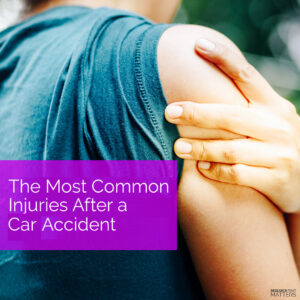section-02280fe
Whiplash: How These Injuries Can Cause Chronic Pain
 Bottom Line:
Bottom Line:
Whiplash injuries used to be considered “no big deal’, but times have changed. Doctors now know that whiplash can cause lifelong pain and disability if not treated properly. During a car accident, the head often suddenly moves forward and backward with a tremendous amount of force. Even low-speed collisions can generate enough force to injure the delicate ligaments in your neck that support your head.
Why it Matters:
When you experience a whiplash injury, your head and neck extend beyond their normal range of motion. This can create partial tears or other damage to the muscles and ligaments around your spine and injure the spinal disc, nerves, or muscles. A few key indicators that you may have suffered a whiplash injury include neck pain and stiffness, headaches, dizziness, pain into your arms/shoulders, or limited range of motion.
- It’s estimated that over 80% of people involved in a car accident will sustain whiplash injuries.
- Whiplash injuries are now considered severe, and often permanent injuries to the ligaments of the neck occur after the rapid back and forth motion experienced during an accident.
- What’s more, nearly 50% of people with neck pain or whiplash following a car accident will continue to have pain one year after their initial injury.
Next Steps:
Receiving the proper diagnosis and care after a car accident can help reduce your likelihood of struggling with a lifetime of chronic neck pain. Our practice is focused on accurately assessing, documenting, and treating people who have been involved in a car accident. We’d ready to help you regain your quality of life as quickly and safely as possible!
Science Source(s):
section-3845968
What You Need to Know About Delayed Pain After a Car Accident
 Bottom Line:
Bottom Line:
If you can walk away after a car accident without any catastrophic injuries, you may consider yourself lucky! Even if you feel ok after exchanging information and speaking with the police, it’s always a good idea to see a Chiropractor following an auto accident. With your adrenaline pumping in the aftermath, your brain may not immediately register the pain signals coming from your body. Often only after you’ve had some time to calm down do you notice you may be struggling with aches and pains.
Why it Matters:
Ignoring a new ache or pain after a car accident and hoping it will go away is not smart. Even minor symptoms can be an indication of a more significant problem.
Receiving a complete and thorough evaluation is critical to discovering any injuries early on so that you can receive the best care and treatment to put those injuries in the rearview mirror as quickly as possible.
The following symptoms often have a delayed onset and may not appear for hours (or even days!) after an auto accident:
- Headaches: A concussion, neck injury, mild traumatic brain injury, or whiplash can lead to chronic headaches after a car accident. Don’t dismiss a headache or dizziness until it’s been adequately evaluated by a doctor.
- Back pain: Pain in your back following a car accident can take hours or days to surface. This could be a sign of a spinal disc, soft tissue, or whiplash injury.
- Neck/Shoulder Pain: If you notice pain in your neck, shoulders, or arms, it may be a sign of a whiplash or spinal injury.
Next Steps:
Delayed onset of symptoms after a car accident is quite common. It doesn’t mean that you’re “making it up.” The stress of a car accident can make it difficult to truly assess how you feel minutes after the event. It takes time for swelling and inflammation to begin, and if you notice pain hours or days after your auto accident, don’t dismiss it. Get a proper evaluation as soon as you can. Doing so has the potential to make a massive difference in your quality of life!
Science Source(s):
section-8702f34
How to Recover from Whiplash After an Auto Accident
 Bottom Line:
Bottom Line:
Your spine is a long chain of bones, discs, muscles, and ligaments that extend from your skull down to your tailbone. The cervical spine – better known as your neck – is designed to support your head and protects the nerves that connect to your face, shoulders, and arms. Whiplash injuries can create damage to these delicate structures and can cause symptoms such as headaches, neck pain, stiffness, shoulder pain, numberless, and tingling / pain into the arms and hands.
Why it Matters:
Even minor damage to the ligaments of your neck (a hallmark of whiplash) can take up to 12 weeks to heal. Depending on the severity of the ligament tearing, these injuries may also be classified as permanent.
Significant damage to the supporting ligaments is known as spinal instability, and it’s essential to limit any inflammation early on in your treatment and to improve your range of motion. While it may seem strange that movement can be a good thing even if it may hurt, know that carefully controlled movement can limit the amount of scar tissue that forms and may even increase the rate of healing.
- Obtaining an accurate diagnosis through a complete examination and spinal imaging is the first step towards determining the best plan of care to heal your injuries.
- Inflammation is one of the primary factors that causes pain and restricted movement after sustaining a whiplash injury.
- Controlling inflammation naturally and re-establishing your range of motion can reduce your pain and improve the results of your care.
Next Steps:
Chiropractors take a holistic approach to helping you recover from whiplash by examining and treating the injured muscles, ligaments, discs, and more. By focusing on improving your movement, biomechanics, and functional ability – while reducing your pain – it’s no wonder that Chiropractors are considered an essential part of a person’s healthcare team especially after an auto accident.
Science Source(s):
section-1bd1ad9
The Most Common Injuries After a Car Accident
 Bottom Line:
Bottom Line:
Whether you’re driving to work or taking a big family vacation, an unexpected car accident can cause painful injuries that may impact you for months and years to come. The weight of your vehicle combined with your speed can create a tremendous amount of force. During an auto accident, that force gets transferred directly to your body! Even “low speed” collisions can create enough force to cause serious injuries.
Why it Matters:
Seat belts save millions of lives each year and should be used every time you enter a vehicle. No questions. What you may not know is that they also can contribute to a few of the most common spinal injuries seen following an auto accident.
The sudden stop or change in direction that often occurs during a car accident can place a tremendous amount of force on your chest. Your unsecured arms and legs can also strike your vehicle’s interior, causing injury.
Here are a few of the most common injuries that occur during a car accident.
- Head Injuries: Striking your head against the steering wheel, dashboard, or window can result in severe injury such as a concussion (which is considered a mild traumatic brain injury).
- Spinal Injuries: The competing forces experienced during a car accident can result in spinal injuries like instability, whiplash, or herniated discs.
- Arm or Leg Injuries: Injuries to your shoulders (if you’re holding the wheel) or your knees (if they hit the door or dashboard) are very common during a car accident.
Next Steps:
If you’re in a car accident, regardless of whether it’s major or minor, it is important to seek medical attention. Properly documenting your cuts and scrapes, evaluating your spine, and evaluating if you’ve suffered any head injuries is nearly impossible to do without the help of a trained medical professional, so don’t put it off. Make a mental note right now to make it a priority and know that we’re always here to help if you have any questions or have recently experienced an auto accident yourself.
Science Source(s):









